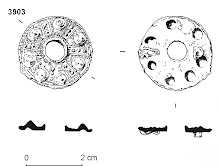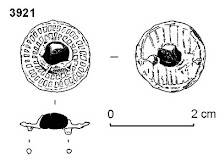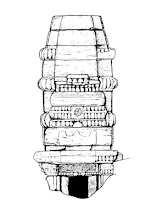For those of us interested in chamber pots, there is a fascinating and wonderfully illustrated article in Ceramics in America by Ivor Noel Hume. It is from 2003 but since the ceramics in question are several centuries old, that hardly matters...
Ivor Noel Hume started his archaeological career in London, before moving to the States where he worked for many years at Colonial Williamsburg. He was a pioneer in both stratigraphic excavation in the States, and post-medieval archaeology. His excellent autobiography 'A passion for the past' was published in 2010 http://www.upress.virginia.edu/title/1502, below is a review I wrote for Diggers' Forum:
An accidental archaeologist?
Review: A Passion for the Past: the Odyssey of a Transatlantic Archaeologist by Ivor Noël Hume
Chiz Harward
Ivor Noël Hume is probably not a name familiar to many professional
British archaeologists, however he worked in the City of London at a key moment
in the development of post-war salvage archaeology and was a key figure in the
study of post-medieval remains in the UK. His subsequent move to Virginia USA
to work on the Colonial Williamsburg site put him at the centre of the emerging
discipline of American historical archaeology. Noël Hume has set out his life
in his auto-biography, adding a personal perspective to events which are better
known from the formal reports and from legends passed from site hut to site
hut.
Noël Hume's early life is chronicled in the first third of
the book, an account of an unsettled and rather complicated childhood before
and during the war which is written with a dry wit reminiscent of Eric Newby.
Passing comments reveal a nascent interest in matters archaeological although
most interesting is his honest recollection of a childhood visit to the
excavations at Sutton Hoo: 'In hazy retrospect I like to think of this…as my
initiation into the world of professional archaeology, though at the time it
made little impression. On the contrary, nothing much seemed to be going on,
prompting the conclusion that if this was what archaeology was all about, it
was slightly less exciting than watching apples grow.' Still, archaeology must
have made some impression as when asked aged 16½ what career he wanted to
pursue, he replied “I want to be an archaeologist, sir” to which his 'Uncle'
John snapped “I'm not asking you to choose a hobby. Young man, archaeology's a
vocation, not a profession!”
The young Noël Hume (INH) was in fact rather more interested
in the theatre, and his early 'career' was as an actor, stage manager and
playwright, rather than archaeologist. His itinerant and poorly paid acting
life would have given him the life skills needed to be a modern-day circuit
digger, but more importantly it gave him an ability to communicate, to tell a
story, and to build props. The life of an aspiring actor did not however pay
well and a penniless INH wandered the streets of London, watching trials at the
Old Bailey and, inspired by a talk on the radio, he drifted into mudlarking,
the searching out of artefacts from the Thames foreshore. An additional bonus
of mudlarking were the finds of forged coins –not Roman or medieval forgeries,
but half crowns, shillings and sixpences which could be palmed off on harassed
bus drivers and laundered into real currency to pay for food.
INH's progress from mudlarking to bona fide archaeologist came from wanting to know what his
mudlarked treasures were, with Adrian Oswald at the Guildhall Museum filling
the role of the Finds Liaison Officer. Oswald clearly had an effect on Noël
Hume as he spent more and more time in the Guildhall Museum, and less time trying
for jobs in the theatre. Oswald also clearly taught Noel Hume well; INH obviously
had an aptitude for archaeology for despite having no formal training in
archaeology he clearly picked up the principles and application of
stratigraphy, typology and excavation techniques, although there was little
opportunity for formal excavation and much of his work was purely artefact
retrieval. INH’s future wife, Audrey,
also worked at the Guildhall Museum, where she was one of three female
‘Guildhall Iregulars’. Audrey made her own career alongside INH in the UK and
US and was a talented archaeologist in her own right.
The early development of archaeological research in the City
of London has been well-documented, but INH's book gives a more personal
account of the period when the era of collecting artefacts from workmen was moving
towards more archaeological work on their context. The redevelopment of the
blitzed City meant that there were huge potential opportunities for research,
but limited funds, equipment or personnel
(and the rivalries between the two museums collecting in the City, the
Guildhall Museum and the London Museum) meant that little was saved. INH’s
personal memories of these rivalries are fascinating and shed light on aspects only
briefly touched on in more academic papers. There were rivalries and stresses too
within the Guildhall Museum team, most famously over the exhibiting of some
unconserved Roman goat-skin ‘Bikini trunks’ on the TV quiz show Animal, Vegetable,
Mineral which indirectly led to INH and Audrey leaving for the US.
For the past 40 years London archaeologists have been
revisiting the sites visited by INH and his team, and by other relatively
unsung archaeologists: Norman and Reader (who coined the term 'Dark Earth'),
Oswald, Lambert, Cottrill, Waddington, and later Merrifield and Marsden. Where we now have the opportunity to record
the full sequence, the early archaeologists could only pick at the sides of the
trenches, grabbing artefacts and sketching sequences and taking the odd photo. What
is perhaps most striking is the stratigraphic rigour with which Noël Hume
worked despite the circumstances. Although
he had only limited archaeological training (and there are few details here on
any further training received or self-taught), he clearly had a grasp of
sequence, or what was important and what was not.
INH does not dwell on the development of rescue archaeology
and subsequently commercial archaeology in London or the wider UK, and it would
be very interesting to know Noël Hume's views on the major archaeological
excavations of the last 40 years and on what may have been lost. Today when
every development in the City is considered for its archaeological impact, it
is hard to really understand what it was like back then, hauling sacks of finds
back to the Guildhall (including on one occasion tramping up the Lord Mayor's
red carpet). The need for reconstructed
pots and artefacts to show the public and highlight the work of the Guildhall
Museum -I have held some of those pots
and can now better understand the fairly crude reconstruction work, complete
with oil paints, which must have reminded him of his days as a stage manager
building props.
The third part of the book deals with INH's career with
Audrey following his move to America to the historical site of Colonial
Williamsburg in Virginia. Here almost his first action was to build a model of
stratigraphy, and to try and move on from the ‘wall-chasing’ of the existing
archaeologists. INH had a varied and illustrious career in Virginia, with the
odd theatrical show, and made a valuable contribution to museum studies, although
it is clear that in later years both changing priorities and administrations
took their toll on his work and his happiness.
The book should be of interest to everyone interested in the
story of the archaeology of London, and in the history of the period when
modern archaeology really emerged in this country. It is refreshing that INH
brings a personal view to the often personal relationships between the names
that are now better known through their academic books. His accounts of digging
in the City are a useful reminder of how much was done with so little, and that
personalities –then as now- can interfere with the pursuit of archaeological
research. The book is very much a personal tale, rather than a summary of
professional achievements; a narrative of a life, albeit unintended, in
archaeology.
A Passion for the Past: the Odyssey of a Transatlantic
Archaeologist, by Ivor Noël Hume, University of Virginia Press
ISBN 978-0-8139-2977-4













